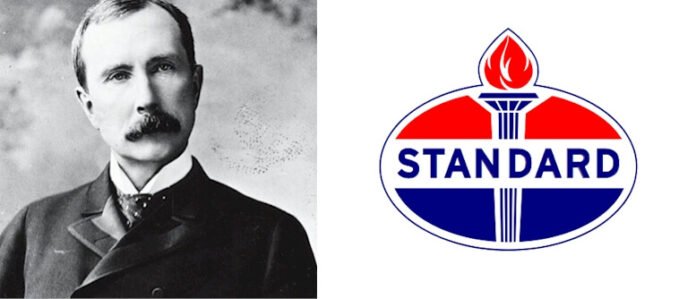Let’s get an insight into the Standard Oil logo and some history behind the empire.
Standard Oil has had an incredible history: it’s a mix of ambition, persuasion, ruthless, greed, and charity. This blend of virtues and vices made its leading founder, John Davison Rockefeller, the most hated but admired American entrepreneur.
With some business success under his belt, Rockefeller led a group of investors to start Standard Oil. It was in 1870, a period when the oil industry was growing and prices constantly fluctuating. To control this unstable pricing condition, Rockefeller allied with refiners and railroads.
By 1872, Standard Oil controlled almost all the oil refineries in Cleveland. And by 1880, it held about ninety percent of the oil production in the United States. Then, a couple of years later, it became Standard Oil Trust in 1882. With this new structure, it became more powerful.
However, in 1911, the US Supreme Court used the Sherman Antitrust Act to divide the company. The aim was to protect smaller refineries and also encourage competition. Despite this breakup, it’s interesting to note that some modern oil brands trace their roots to the empire.
For instance, you can name BP, Chevron, ExxonMobil, and Marathon. These companies have grown to become global brands, and their presence shows the impact of Standard Oil on the oil industry. It has left an indelible legacy that can’t be ignored but to be studied.
The company adopted the US colors for its logo to convey its patriotism. This emblem comprised a sphere, torch, and wordmark. The frame’s oval is divided into three sections: red, white, and blue. Also, you’ll find the torch and the caption—Standard at the center.
The Standard Oil logo was attractive, simple, memorable, and readable. Also, it was influential, representing the company through the good and bad times. Finally, it was a logo of authority.
Standard Oil Logo Evolution And Its History
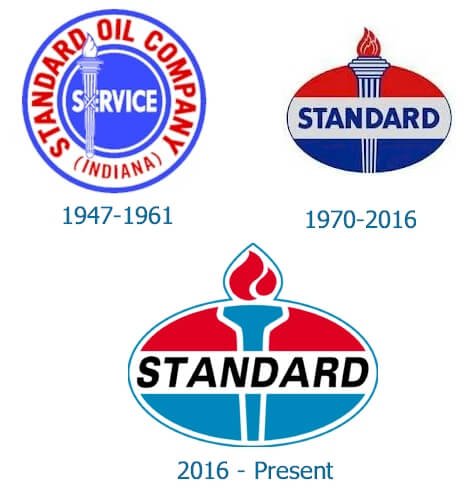
Though Standard Oil started in1870, it was until 1911 that its first known logo appeared. It came in a circular form with the colors of the US flag as its official colors. Then, after about thirty-six years, the company updated it into a spherical type. It also kept the American color identity.
In 1961, Standard Oil refreshed its logo for the second time. Yet, the changes weren’t overwhelming. Lastly, in 1973, the company carried out another update, streamlining the logo further. Overall, the company has been consistent with its identity. Now, let’s dig further.
1911—1947—The Circular Logo
Standard Oil unveiled its circular logo in 1911. It comprised three circles with inscriptions. While the first circle contained the word—Service, the third one had the brand’s name—Standard Oil Company (Indiana.) These readable captions were written in uppercase letterings. The designer placed a torch next to the letter—S, blocking the letter—E to add a bit of creativity. Overall, the emblem dazzled in the United States national colors—red, white, and blue.
1947—1961—The Spherical Logo
In 1947, Standard Oil introduced its updated logo. It came in a spherical form, keeping the idolized United States’ colors. Here, the designer rendered the colors in a horizontal pattern. In addition, he placed the torch at the center of the emblem. Compared to the past logo, the chosen colors were dark. Yet, they paved the way for the company’s name to be readable.
1961—1973—The Second Spherical Logo
After 14 years of using its second emblem, Standard Oil released a new logo. This logo kept the previous design but with a few refreshments. And compared to its predecessor, this one is clean. For instance, the white color gave a more contrasting effect to the other elements. Also, the torch was more refined and pleasing. Finally, the emblem had a protective outline around it.
1973—Present—The Current Logo
In 1973, Standard Oil unveiled another logo. Yet, it was in line with the brand’s core personality. Here, the designer replaced the deep blue color with a lighter tone. Also, the brand’s name turned black instead of blue. In addition, the stripped torchlight became a filled type. Finally, the flame above the torch had two divisions, and it was clean.
Standard Oil Logo Design Elements
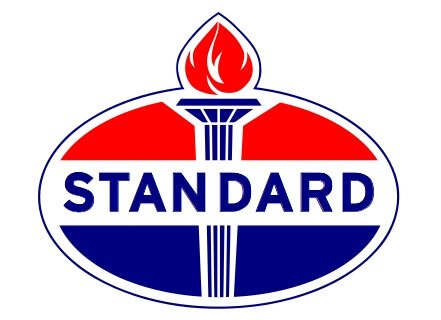
Standard Oil kept its design elements to four. The designer used a shape, symbol, font, and three colors. Together, these elements created a visual identity that represented the oil industry and the American sense of nationalism. Also, the logo is clean and pleasing to the eye. To further understand some of these graphic elements, let’s examine their symbolism:
Standard Oil Logo Shape And Symbols
- A Sphere:
A sphere was the renowned frame for the Standard Oil logo, and it held the other elements to convey the company’s values. As a sacred symbol, it signifies wholeness, oneness, and timelessness. Also, some traditions associate it with fertility because it looks like an egg.
- A Torch:
Another consistent symbol in the logo was a torch. First, it’s a sign of enlightenment. Interestingly, a torch is universally accepted to signify freedom and knowledge across the world. Also, it represents the power of liberty and inspiration. Finally, it’s a source of light.
Standard Oil Logo Colors
- A Blue Color:
Blue aligns with the open sky. And throughout history, people have labeled it as the color of trust. Again, its presence conveys the feeling of calmness, safety, and freedom. In addition, it signifies confidence, loyalty, and intelligence. Now, you’ll find it marking the wordmark and other logo elements. Yet, despite these positives, blue can ignite the feeling of sadness.
- A Red Color:
Red resonates with blood, and it’s the most vibrant color. Across cultures, people have used it to represent varying emotions. These include courage, love, vigor, and desire. However, it can also ignite anger, stress, and lust. So, like the blue, it also marked a couple of elements on the logo.
- A White Color:
The color white had a powerful presence in the Standard Oil emblem. Interestingly, several traditions align it with virtues. So, it conveys the feeling of purity, peace, and humility. Also, it represents cleanliness, simplicity, safety, and perfection. And in each of the logos, it gave a powerful balancing effect. Overall, white promotes a sense of freshness and renewal.
- A Black Color:
Experts regard black as the absence of color. Again, they associate it with the unknown. In one logo, black beautified the company’s wordmark. It’s a color that signifies prestige, wealth, authority, and elegance, and these represent positive emotions. In contrast, the color of mystery can also represent aggression, death, danger, and fear.
What Was the Standard Oil Logo?
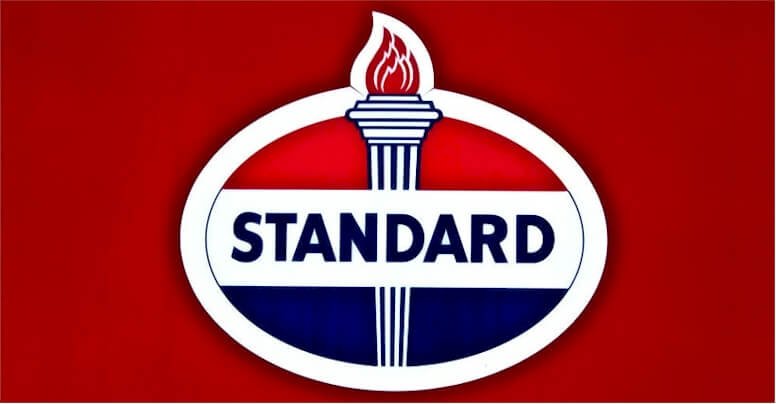
The Standard Oil logo featured a sphere with a torch at its center. This geometric shape had three segments colored red, white, and blue. And they are associated with the United States flag, representing the founder’s spirit of nationalism. Now, the white middle part housed the caption—standard in caps. Finally, the torch represented the power of fuel.
Why Was It Called Standard Oil?
Standard Oil was once the world’s largest oil refinery company. The founder, John D. Rockefeller, adopted Standard Oil in 1870. The aim was simple—to become the pacesetter by providing a uniform oil consistently. With this goal, it became the industry leader, setting the standard for others to follow. Interestingly, it controlled all the processes—from production to final delivery to consumers. That’s how ambitious the company was in those years.
What Companies Did Standard Oil Split Into?
In the 1900s, the United States government saw Standard Oil as a threat. She reasoned that the company was operating a monopoly and weighed too much power. So, in 1911, the US Supreme Court passed a law to divide the oil giant into seven companies.
These were Standard Oil of New Jersey, Standard Oil of New York, and Standard Oil of California. The rest included Standard Oil of Indiana, Standard Oil of Kentucky, The Standard Oil Company (Ohio), and The Ohio Oil Company.
Later, these companies were bought or merged with other brands.
Who Founded Standard Oil Company?
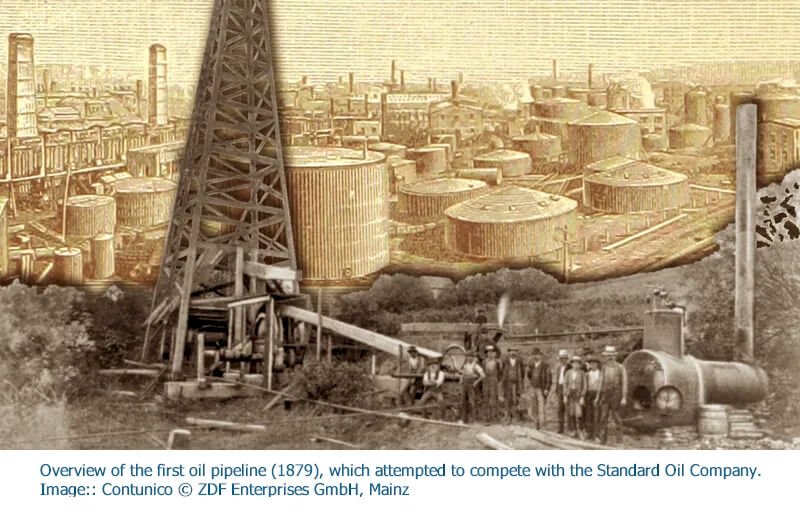
John Rockefeller was well-known to be the founder of Standard Oil. However, he co-founded the company with four other entrepreneurs: Samuel Andrews, William A. Rockefeller, Stephen Harkness, and Henry Flagler. William was his brother.
John Rockefeller was an American entrepreneur and a philanthropist. On July 8, 1839, he was born to William Rockefeller and Eliza Davison. And out of six children, he was the second child born in Richford, New York.
With little formal education, Rockefeller became an assistant bookkeeper at 16. He worked for Hewitt & Tuttle, receiving $31 monthly during his first year. Rockefeller had a modest ambition—to earn $100,000 while living to be 100 years old.
He was two years and two months short of this age target when he died.
In 1859, Rockefeller entered a partnership with Maurice Clark. But he had only $800 saved, so he borrowed $1000 from his dad at 10 percent interest. Luckily, the business proved successful, making the partners good profit. Later, they turned their focus towards the oil business in 1863.
Then, in 1864, he married Laura Celestia. Together, they had five children—a son and four daughters. The son, John D. Rockefeller Jr., would later take over the business, treading his father’s footpaths. Now, six years after marriage, Rockefeller founded Standard Oil with others.
With draconian strategies, he dominated the market, creating a monopoly in the industry. For instance, by 1878, Rockefeller and his partners controlled ninety percent of the oil market in the United States. This dominance didn’t go unnoticed, so, in 1911, he felt the hot arms of the law.
On May 23, 1937, he died at home in Ormond Beach, Florida. He was ninety-seven, two years and two months short of his 100th dream. But before his death, he donated massively to charities.
A Brief History of Standard Oil Company
Standard Oil Company was an American oil giant specializing in production, refining, transportation, and marketing. In 1863, John D. Rockefeller teamed up with the Clark brothers and Samuel Andrews, a chemist, to start a refinery in Cleveland, Ohio.
These ambitious men bought oil wells in Titusville, Pennsylvania, and created a well in Cleveland. Then two years later, Rockefeller purchased the shares of the Clark brothers, forming Rockefeller and Andrews Oil Company. The company made about $200,000 within that year.
However, the oil business was at its infant stage. And therefore, the market was restricted to domestic lighting. During this period, the major challenge faced by entrepreneurs was unstable pricing. So, to mitigate this issue, Rockefeller and Samuel unveiled a strategy to O.H Payne.
First, they reasoned with him to unite with them. The logic is that they can easily control the price of the market with a united oil company. At the time, Payne owned the largest oil refinery in Cleveland. They continued with this strategy, buying and driving others out of the industry.
Then finally, in 1870, Rockefeller teamed up with William, Samuel, Henry, and Stephen to form Standard Oil Company of Ohio. Primarily, the company focused on oil refining.
Eight years after its formation, Standard Oil controls about ninety percent of the oil refinery in the United States. Then, in 1881, it became known as the Standard Oil Trust. This trust-owned about forty companies, which took nine trustees to create.
And per the agreement, they can buy, create, dissolve, merge, or split any oil company they deem fit. With this structure in place, the trust’s operations caught the federal government’s attention. Here, the government thought Rockefeller had monopolized the oil industry.
So, in 1911, the US Supreme Court ordered the breaking up of Standard Oil Trust. Interestingly, the court acted on an antitrust act proposed by John Sherman, an Ohio senator. Finally, the court ruling led to the splitting of Standard Oil into several significant subsidiaries.
Despite these divisions, the same actors ran the companies in practice. And while the name Standard Oil may no longer exist, some of the major players today have its root.
Concluding Remarks On the Standard Oil Logo And Its History
William Rockefeller and Eliza Davison were the parents of John Davison Rockefeller. The father was a salesman while the mother was a homemaker. Together, they had six children, and Rockefeller was the second child. He was born in Richford, New York, on July 8, 1839.
As a young boy, Rockefeller studied bookkeeping at Folsom’s Commercial College. It was a ten-week course that gave him the basis of accounting. So, with this training, Hewitt & Tuttle hired him as an assistant bookkeeper. He earned $31 monthly for his first year as a bookkeeper.
Later, he partnered with four investors—Samuel, William, Stephen, and Henry to form Standard Oil. This happened on January 10, 1870. Within ten years, Standard Oil dominated the oil industry. The owners used several means to influence the competition, creating a monopoly.
However, it took the enforcement of the Sherman Antitrust Act in 1911 to split the company. It’s on record that Standard Oil broke into thirty-four independent companies. Today, you can still see its descendants playing a pivotal role in the oil industry globally.
The company’s first known logo appeared in 1911. Then, it went through three updates, from 1947, 1961, and 1973. These four logos kept a consistent identity that conveyed their core values. Again, the Standard Oil logo evoked the spirit of American patriotism.

